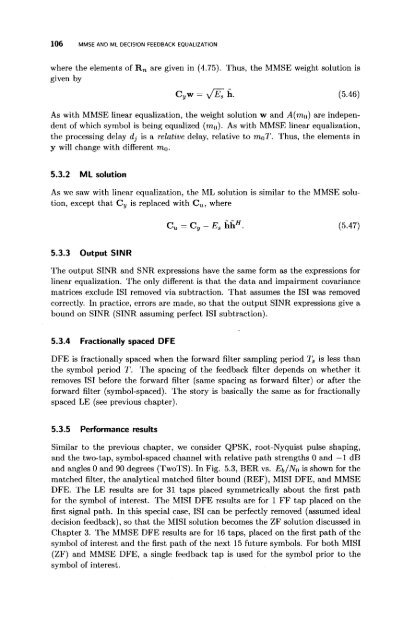mohatta2015.pdf
signal processing from power amplifier operation control point of view
signal processing from power amplifier operation control point of view
Create successful ePaper yourself
Turn your PDF publications into a flip-book with our unique Google optimized e-Paper software.
106 MMSE AND ML DECISION FEEDBACK EQUALIZATION<br />
where the elements of R n are given in (4.75). Thus, the MMSE weight solution is<br />
given by<br />
C„w = y/Ίζ h. (5.46)<br />
As with MMSE linear equalization, the weight solution w and A(mo) are independent<br />
of which symbol is being equalized (m () ). As with MMSE linear equalization,<br />
the processing delay dj is a relative delay, relative to m^T. Thus, the elements in<br />
y will change with different mo.<br />
5.3.2 ML solution<br />
As we saw with linear equalization, the ML solution is similar to the MMSE solution,<br />
except that C y is replaced with C u , where<br />
C = C„ - E s hh". (5.47)<br />
5.3.3 Output SINR<br />
The output SINR and SNR expressions have the same form as the expressions for<br />
linear equalization. The only different is that the data and impairment covariance<br />
matrices exclude ISI removed via subtraction. That assumes the ISI was removed<br />
correctly. In practice, errors are made, so that the output SINR expressions give a<br />
bound on SINR (SINR assuming perfect ISI subtraction).<br />
5.3.4 Fractionally spaced DFE<br />
DFE is fractionally spaced when the forward filter sampling period T s is less than<br />
the symbol period T. The spacing of the feedback filter depends on whether it<br />
removes ISI before the forward filter (same spacing as forward filter) or after the<br />
forward filter (symbol-spaced). The story is basically the same as for fractionally<br />
spaced LE (see previous chapter).<br />
5.3.5 Performance results<br />
Similar to the previous chapter, we consider QPSK, root-Nyquist pulse shaping,<br />
and the two-tap, symbol-spaced channel with relative path strengths 0 and —1 dB<br />
and angles 0 and 90 degrees (TwoTS). In Fig. 5.3, BER vs. Eb/N n is shown for the<br />
matched filter, the analytical matched filter bound (REF), MISI DFE, and MMSE<br />
DFE. The LE results are for 31 taps placed symmetrically about the first path<br />
for the symbol of interest. The MISI DFE results are for 1 FF tap placed on the<br />
first signal path. In this special case, ISI can be perfectly removed (assumed ideal<br />
decision feedback), so that the MISI solution becomes the ZF solution discussed in<br />
Chapter 3. The MMSE DFE results are for 16 taps, placed on the first path of the<br />
symbol of interest and the first path of the next 15 future symbols. For both MISI<br />
(ZF) and MMSE DFE, a single feedback tap is used for the symbol prior to the<br />
symbol of interest.



